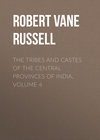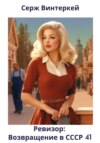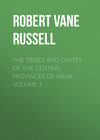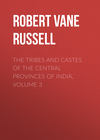Читать книгу: «The Tribes and Castes of the Central Provinces of India, Volume 4», страница 52
10. Ear-piercing
Before treating of ear-ornaments it will be convenient to mention briefly the custom of ear-piercing. This is universal among Hindus and Muhammadans, both male and female, and the operation is often performed by the Sunār. The lower Hindu castes and the Gonds consider piercing the ears to be the mark of admission to the caste community. It is done when the child is four or five years old, and till then he or she is not considered to be a member of the caste and may consequently take food from anybody. The Rāj-Gonds will not have the ears of their children pierced by any one but a Sunār; and for this they give him sīdha or a seer651 of wheat, a seer of rice and an anna. Hindus employ a Sunār when one is available, but if not, an old man of the family may act. After the piercing a peacock’s feather or some stalks of grass or straw are put in to keep the hole open and enlarge it. A Hindu girl has her ear pierced in five places, three being in the upper ear, one in the lobe and one in the small flap over the orifice. Muhammadans make a large number of holes all down the ear and in each of these they place a gold or silver ring, so that the ears are dragged down by the weight. Similarly their women will have ten or fifteen bangles on the legs. The Hindus also have this custom in Bhopāl, but if they do it in the Central Provinces they are chaffed with having become Muhammadans. In the upper ear Hindu women have an ornament in the shape of the genda or marigold, a sacred flower which is offered to all the deities. The holes in the upper and middle ear are only large enough to contain a small ring, but that in the lobe is greatly distended among the lower castes. The tarkhi or Gond ear-ornament consists of a glass plate fixed on to a stem of ambāri fibre nearly an inch thick, which passes through the lobe. As a consequence the lower rim is a thin pendulous strip of flesh, very liable to get torn. But to have the hole torn open is one of the worst social mishaps which can happen to a woman. She is immediately put out of caste for a long period, and only readmitted after severe penalties, equivalent to those inflicted for getting vermin in a wound. When a woman gets her ear torn she sits weeping in her house and refuses to be comforted. At the ceremony of readmission a Sunār is sometimes called in who stitches up the ear with silver thread.652 Low-caste Hindu and Gond women often wear a large circular embossed silver ornament over the ear which is known as dhāra or shield and is in the shape of an Indian shield. This is secured by chains to the hair and apparently affords some support to the lower part of the ear, which it also covers. Its object seems to be to shield and protect the lobe, which is so vulnerable in a woman, and hence the name. A similar ornament worn in Bengal is known as dhenri and consists of a shield-shaped disk of gold, worn on the lobe of the ear, sometimes with and sometimes without a pendant.653
11. Origin of ear-piercing
The character of the special significance which apparently attaches to the custom of ear-piercing is obscure. Dr. Jevons considers that it is merely a relic of the practice of shedding the blood of different parts of the body as an offering to the deity, and analogous to the various methods of self-mutilation, flagellation and gashing of the flesh, whose common origin is ascribed to the same custom. “To commend themselves and their prayers the Quiches pierced their ears and gashed their arms and offered the sacrifice of their blood to their gods. The practice of drawing blood from the ears is said by Bastian to be common in the Orient; and Lippert conjectures that the marks left in the ears were valued as visible and permanent indications that the person possessing them was under the protection of the god with whom the worshipper had united himself by his blood offering. In that case earrings were originally designed, not for ornament, but to keep open and therefore permanently visible the marks of former worship. The marks or scars left on legs or arms from which blood had been drawn were probably the origin of tattooing, as has occurred to various anthropologists.”654 This explanation, while it may account for the general custom of ear-piercing, does not explain the special guilt imputed by the Hindus to getting the lobe of the ear torn. Apparently the penalty is not imposed for the tearing of the upper part of the ear, and it is not known whether men are held liable as well as women; but as large holes are not made in the upper ear at all, nor by men in the lobe, such cases would very seldom occur. The suggestion may be made as a speculation that the continuous distension of the lobe of the ear by women and the large hole produced is supposed to have some sympathetic effect in opening the womb and making child-birth more easy. The tearing of the ear might then be considered to render, the women incapable of bearing a child, and the penalties attached to it would be sufficiently explained.
12. Ornaments worn as amulets
The above account of the ornaments of a Hindu woman is sufficient to show that her profuse display of them is not to be attributed, as is often supposed, to the mere desire for adornment. Each ornament originally played its part in protecting some limb or feature from various dangers of the seen or unseen world. And though the reasons which led to their adoption have now been to a large extent forgotten and the ornaments are valued for themselves, the shape and character remain to show their real significance. Women as being weaker and less accustomed to mix in society are naturally more superstitious and fearful of the machinations of spirits. And the same argument applies in greater degree to children. The Hindus have probably recognised that children are very delicate and succumb easily to disease, and they could scarcely fail to have done so when statistics show that about a quarter of all the babies born in India die in the first year of age. But they do not attribute the mortality to its real causes of congenital weakness arising from the immaturity of the parents, insanitary treatment at and after birth, unsuitable food, and the general frailty of the undeveloped organism. They ascribe the loss of their offspring solely to the machinations of jealous deities and evil spirits, and the envy and admiration of other people, especially childless women and witches, who cast the evil eye upon them. And in order to guard against these dangers their bodies are decorated with amulets and ornaments as a means of protection. But the result is quite other than that intended, and the ornaments which are meant to protect the children from the imaginary terrors of the evil eye, in reality merely serve as a whet to illicit cupidity, and expose them a rich, defenceless prey to the violence of the murderer and the thief.
13. Audhia Sunārs
The Audhia Sunārs usually work in bell-metal, an alloy of copper or tin and pewter. When used for ornaments the proportion of tin or pewter is increased so as to make them of a light colour, resembling silver as far as may be. Women of the higher castes may wear bell-metal ornaments only on their ankles and feet, and Marātha and Khedāwāl Brāhmans may not wear them at all. In consequence of having adopted this derogatory occupation, as it is considered, the Audhia Sunārs are looked down on by the rest of the caste. They travel about to the different village markets carrying their wares on ponies; among these, perhaps, the favourite ornament is the kara or curved bar anklets, which the Audhia works on to the purchaser’s feet for her, forcing them over the heels with a piece of iron like a shoe-horn. The process takes time and is often painful, the skin being rasped by the iron. The woman is supported by a friend as her foot is held up behind, and is sometimes reduced to cries and tears. High-caste women do not much affect the kara as they object to having their foot grasped by the Sunār. They wear instead a chain anklet which they can work on themselves. The Sunārs set precious stones in ornaments, and this is also done by a class of persons called Jadia, who do not appear to be a caste. Another body of persons accessory to the trade are the Niārīas, who take the ashes and sweepings from the goldsmith’s shop, paying a sum of ten or twenty rupees annually for them.655 They wash away the refuse and separate the grains of gold and silver, which they sell back to the Sunārs. Niāria also appears to be an occupational term, and not a caste.
14. The Sunār as money-changer
Formerly Sunārs were employed for counting and testing money in the public treasuries, and in this capacity they were designated as Potdār and Sarāf or Shroff. Before the introduction of the standard English coinage the money-changer’s business was important and profitable, as the rupee varied over different parts of the country exactly as grain measures do now. Thus the Pondicherry rupee was worth 26 annas, while the Gujarat rupee would not fetch 12½ annas in the bazār. In Bengal,656 at the beginning of the nineteenth century, people who wished to make purchases had first to exchange their rupees for cowries. The Potdar carried his cowries to market in the morning on a bullock, and gave 5760 cowries for a new kaldār or English rupee, while he took 5920 cowries in exchange for a rupee when his customers wanted silver back in the evening to take away with them. The profit on the kaldār rupee was thus one thirty-sixth on the two transactions, while all old rupees, and every kind of rupee but the kaldār, paid various rates of exchange or batta, according to the will of the money-changers, who made a higher profit on all other kinds of money than the kaldār. They therefore resisted the general introduction of these rupees as long as possible, and when this failed they hit on a device of marking the rupees with a stamp, under pretext of ascertaining whether they were true or false; after which the rupee was not exchangeable without paying an additional batta, and became as valuable to the money-changers as if it were foreign coin. As justification for their action they pretended to the people that the marks would enable those who had received the rupees to have them changed should any other dealer refuse them, and the necessities of the poor compelled them to agree to any batta or exchange rather than suffer delay. This was apparently the origin of the ‘Shroff-marked rupees,’ familiar to readers of the Treasury Manual; and the line in a Bhāt song, ‘The English have made current the kaldār (milled) rupee,’ is thus seen to be no empty praise.
15. Malpractices of lower-class Sumārs
As the bulk of the capital of the poorer classes is hoarded in the shape of gold and silver ornaments, these are regularly pledged when ready money is needed, and the Sunār often acts as a pawnbroker. In this capacity he too often degenerates into a receiver of stolen property, and Mr. Nunn suggested that his proceedings should be supervised by license. Generally, the Sunār is suspected of making an illicit profit by mixing alloy with the metal entrusted to him by his customers, and some bitter sayings are current about him. One of his customs is to filch a little gold from his mother and sister on the last day of Shrāwan (July) and make it into a luck-penny.657 This has given rise to the saying, ‘The Sunār will not respect even his mother’s gold’; but the implication appears to be unjust. Another saying is: ‘Sona Sunār kā, abharan sansār ka,’ or, ‘The ornament is the customer’s, but the gold remains with the Sunār.’658 Gold is usually melted in the employer’s presence, who, to guard against fraud, keeps a small piece of the metal called chāsnī or māslo, that is a sample, and when the ornament is ready sends it with the sample to an assayer or Chokshi who, by rubbing them on a touchstone, tells whether the gold in the sample and the ornament is of the same quality. Further, the employer either himself sits near the Sunār while the ornament is being made or sends one of his family to watch. In spite of these precautions the Sunār seldom fails to filch some of the gold while the spy’s attention is distracted by the prattling of the parrot, by the coquetting of a handsomely dressed young woman of the family or by some organised mishap in the inner rooms among the women of the house.659 One of his favourite practices is to substitute copper for gold in the interior, and this he has the best chance of doing with the marriage ornaments, as many people consider it unlucky to weigh or test the quality of these.660 The account must, however, be taken to apply only to the small artisans, and well-to-do reputable Sunārs would be above such practices.
The goldsmith’s industry has hitherto not been affected to any serious extent by the competition of imported goods, and except during periods of agricultural depression the Sunār continues to prosper.
A Persian couplet said by a lover to his mistress is, ‘Gold has no scent and in the scent of flowers there is no gold; but thou both art gold and hast scent.’
Sundi, Sundhi, Sunri or Sondhi. 661—The liquor-distilling caste of the Uriya country. The transfer of Sambalpur and the Uriya States to Bihār and Orissa has reduced their strength in the Central Provinces to about 5000, found in the Raipur District and the Bastar and Chota Nāgpur Feudatory States. The caste is an important one in Bengal, numbering more than six lakhs of persons and being found in western Bengal and Bihār as well as in Orissa. The word Sundi is derived from the Sanskrit Shaundik, a spirit-seller. The caste has various genealogies of differing degrees of respectability, tracing their origin to cross unions between other castes born of Brāhmans, Kshatriyas, and Vaishyas. The following story is told of them in Madras.662 In ancient times a certain Brāhman was famous for his magical attainments. The king of the country sent for him one day and asked him to cause the water in a tank to burn. The Brāhman saw no way of doing this, and returned homewards uneasy in his mind. On the way he met a distiller who asked him to explain what troubled him. When the Brāhman told his story the distiller promised to cause the water to burn on condition that the Brāhman gave him his daughter in marriage. This the Brāhman agreed to do, and the distiller, after surreptitiously pouring large quantities of liquor into the tank, set fire to it in the presence of the king. In accordance with the agreement he married the daughter of the Brāhman and the pair became the ancestors of the Sundi caste. In confirmation of the story it is alleged that up to the present day the women of the caste maintain the recollection of their Brāhman ancestors by refusing to eat fowls or the remains of their husbands’ meals. Nor will they take food from the hands of any other caste. Sir H. Risley relates the following stories current about the caste in Bengal, where its status is very low: “According to Hindu ideas, distillers and sellers of strong drink rank among the most degraded castes, and a curious story in the Vaivarta Purāna keeps alive the memory of their degradation. It is said that when Sani, the Hindu Saturn, failed to adapt an elephant’s head to the mutilated trunk of Ganesh who had been accidentally slain by Siva, Viswākarma, the celestial artificer, was sent for, and by careful dissection and manipulation he fitted the incongruous parts together, and made a man called Kedāra Sena from the slices cut off in fashioning his work. This Kedāra Sena was ordered to fetch a drink of water for Bhagavati, weary and athirst. Finding on the river’s bank a shell full of water he presented it to her, without noticing that a few grains of rice left in it by a parrot had fermented and formed an intoxicating liquid. Bhagavati, as soon as she had drunk, became aware of the fact, and in her anger condemned the offender to the vile and servile occupation of making spirituous liquors for mankind.” Like other castes in Sambalpur the Sundis have two subcastes, the Jhārua and the Utkal or Uriya, of whom the Jhāruas probably immigrated from Orissa at an earlier period and adopted some of the customs of the indigenous tribes; for this reason they are looked down on by the more orthodox Utkalis. The caste say that they belong to the Nāgas or snake gotra, because they consider themselves to be descended from Bāsuki, the serpent with a thousand heads who formed a canopy for Vishnu. They also have bargas or family titles, but these at present exercise no influence on marriage. The Sundis have in fact outgrown the system of exogamy and regulate their marriages by a table of prohibited degrees in the ordinary manner, the unions of sapindas or persons who observe mourning together at a death being prohibited. The prohibition does not extend to cognatic relationship, but a man must not marry into the family of his paternal aunt. The fact that the old bargas or exogamous groups are still in existence is interesting, and an intermediate step in the process of their abandonment may be recognised in the fact that some of them are subdivided. Thus the Sāhu (lord) group has split into the Gaj Sāhu (lord of the elephant), Dhavila Sāhu (white lord), and Amila Sāhu sub-groups, and it need not be doubted that this was a convenient method adopted for splitting up the Sāhu group when it became so large as to include persons so distantly connected with each other that the prohibition of marriage between them was obviously ridiculous. As the number of Sundis in the Central Provinces is now insignificant no detailed description of their customs need be given, but one or two interesting points may be noted. Their method of observing the pitripaksh or worship of ancestors is as follows: A human figure is made of kusha grass and placed under a miniature straw hut. A lamp is kept burning before it for ten days, and every day a twig for cleaning the teeth is placed before it, and it is supplied with fried rice in the morning and rice, pulse and vegetables in the evening. On the tenth day the priest comes, and after bathing the figure seven times, places boiled rice before it for the last meal, and then sets fire to the hut and burns it, while repeating sacred verses. On the eleventh day after a death, when presents for the use of the deceased are made to a priest as his representative, the priest lies down in the new bed which is given to him, and the members of the family rub his feet and attend on him as if he were the dead man. He is also given a present sufficient to purchase food for him for a year. The Sundis worship Surādevi or the goddess of wine, whom they consider as their mother, and they refuse to drink liquor, saying that this would be to enjoy their own mother. They worship the still and all articles used in distillation at the rice-harvest and when the new mango crop appears. Large numbers of them have taken to cultivation.
Tamera
1. The Tamera and Kasār
Tamera, Tambatkar.663—The professional caste of coppersmiths, the name being derived from tāmba, copper. The Tameras, however, like the Kasārs or brass-workers, use copper, brass and bell-metal indifferently, and in the northern Districts the castes are not really distinguished, Tamera and Kasār being almost interchangeable terms. In the Marātha country, however, and other localities they are considered as distinct castes. Copper is a sacred metal, and the copper-smith’s calling would be considered somewhat more respectable than that of the worker in brass or bell-metal, just as the Sunār or goldsmith ranks above both; and probably, therefore, the Tameras may consider themselves a little better than the Kasārs. As brass is an alloy made from copper and zinc, it seems likely that vessels were made from copper before they were made from brass. But copper being a comparatively rare and expensive metal, utensils made from it could scarcely have ever been generally used, and it is therefore not necessary to suppose that either the Tamera or Kasār caste came into being before the adoption of brass as a convenient material for the household pots and pans.
Покупайте книги и получайте бонусы в Литрес, Читай-городе и Буквоеде.
Участвовать в бонусной программе













